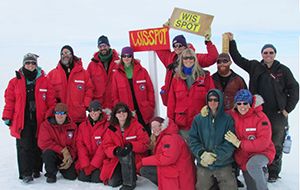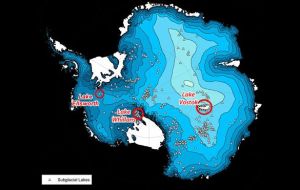MercoPress. South Atlantic News Agency
US team extracts samples from sub-glacial Antarctica lake 800 metres in deep ice
 The special equipment used to drill to obtain samples from the waters and sediments of subglacial Lake Whillans
The special equipment used to drill to obtain samples from the waters and sediments of subglacial Lake Whillans  WISSARD team celebrating the achievement
WISSARD team celebrating the achievement  The British have tried drilling the Ellsworth lake and the Russians, Vostok lake
The British have tried drilling the Ellsworth lake and the Russians, Vostok lake In a first-of-its-kind feat of science and engineering, a US National Science Foundation (NSF)-funded research team has successfully drilled through 800 meters of Antarctic ice to reach a sub-glacial lake and retrieve water and sediment samples that have been isolated from direct contact with the atmosphere for many thousands of years.
Scientists and drillers with the interdisciplinary Whillans Ice Stream Subglacial Access Research Drilling project (WISSARD) announced January 28 that they had used a customized clean hot-water drill to directly obtain samples from the waters and sediments of subglacial Lake Whillans.
The samples may contain microscopic life that has evolved uniquely to survive in conditions of extreme cold and lack of light and nutrients. Studying the samples may help scientists understand not only how life can survive in other extreme ecosystems on Earth, but also on other icy worlds in our solar system.
The WISSARD teams' accomplishment, the researchers said, “hails a new era in polar science, opening a window for future interdisciplinary science in one of Earth's last unexplored frontiers.”
A massive ice sheet, almost two miles thick in places, covers more than 95% of the Antarctic continent. Only in recent decades have airborne and satellite radar and other mapping technologies revealed that a vast, subglacial system of rivers and lakes exists under the ice sheet. Lakes vary in size, with the largest being Vostok Subglacial Lake in the Antarctic interior that is comparable in size to Lake Ontario.
WISSARD targeted a smaller lake (1.2 square miles in area), where several lakes appear linked to each other and may drain to the ocean, as the first project to obtain clean, intact samples of water and sediments from a subglacial lake.
The achievement is the culmination of more than a decade of international and national planning and 3 1/2 years of project preparation by the WISSARD consortium of US universities and two international contributors. There are 13 WISSARD principal investigators representing eight different US institutions.
NSF, which manages the United States Antarctic Program, provided over 10 million dollars in grants as part of NSF's International Polar Year portfolio to support the WISSARD science and development of related technologies.
The National Aeronautics and Space Administration's (NASA) Cryospheric Sciences Program, the National Oceanic and Atmospheric Administration (NOAA), and the private Gordon and Betty Moore Foundation also provided support for the project.
The interdisciplinary research team includes groups of experts in the following areas of science: life in icy environments, led by John Priscu, of Montana State University; glacial geology, led by Ross Powell, of Northern Illinois University; and glacial hydrology, led by Slawek Tulaczyk, of the University of California, Santa Cruz.
Sharing of expertise by the groups of disciplinary experts will allow the data collected to be cast in a systemic, global context.
The WISSARD team will now process the water and sediment samples they have collected in hopes of answering seminal questions related to the structure and function of subglacial microbial life, climate history and contemporary ice-sheet dynamics.
Video surveys of the lake floor and measurements of selected physical and chemical properties of the waters and sediments will allow the team to further characterize the lake and its environs. (US National Science Foundation).-




Top Comments
Disclaimer & comment rules-

-

-

Read all commentsthe results from this may well be very interesting,
Jan 28th, 2013 - 08:03 pm 0we cant wait for the results.
They found a lead plaque from 1833 claiming the territory for Argentina.
Jan 28th, 2013 - 08:53 pm 0Pirates...stealing Argentine lake water...jajajajajajaj
Jan 29th, 2013 - 07:39 am 0Commenting for this story is now closed.
If you have a Facebook account, become a fan and comment on our Facebook Page!